THE LIVING ORGANISMS CHARACTERISTICS AND HABITAT for Class 6 SCIENCE
INTRODUCTION
Hamare aas-paas bahut saare trees, living organisms, non-living things aur bhi bahut saari things present hai. Different places par different type ka climate hota hai aur waha different type ke organisms present hote hai. Iss chapter mein hum different organisms ke different habitat ke baare mein padhenge. Yaha hum janege ki organisms kaise different climate mein adapt karte hai, living beings ki kuchh characteristics jaise reproduction, respiration, growth, stimulus ke respond ke baare mein bhi hum iss chapter mein padhenge.
Organisms And The Surroundings Where They Live
Different organisms different surroundings aur climate mein rehte hai. Eg- Camels desert mein rehte hai, goats aur yak mountains mein rehte hai, crabs beaches par rehte hai, etc. Different places par plants bhi different type ke hi paaye jaate hai. Eg- Oaks, pines, deodars, etc. mountains mein milte hai, cactus plants hot deserts mein paaye jaate hai, casuarina trees sea beaches par paaye jaate hai, etc. Nichhe table mein hum different conditions mein paaye jane wale organisms ki list dek sakte hai. Ab hum inke habitat aur adaptations ke baare men padhenge.
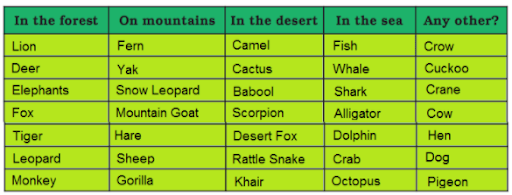
Habitat And Adaptation
Habitat kya hota hai?Habitat- Aisi surroundings jaha living organisms survive karte hai unko habitat kehte hai.
Habitat organisms ko food, water, shelter provide karta hai aur unki other needs ko bhi poora karta hai. Bahut saare organisms ek same habitat mein rehte hai. Ab hum different type ke habitats ke baare mein padhenge.
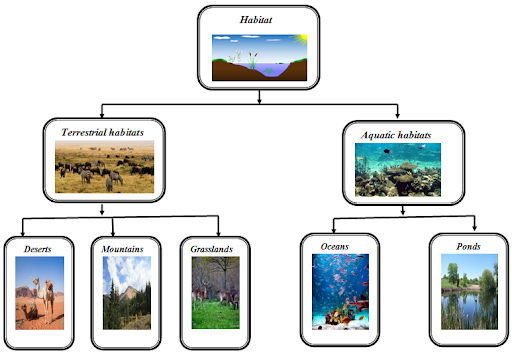
Terrestrial Habitats- Jo plants aur animals land par rehte hai, unko terrestrial organisms kehte hai aur inke habitat ko terrestrial habitats kehte hai.
Example of terrestrial habitats- Forests, grasslands, deserts, coastal and mountain regions.
Aquatic Habitat- Aise plants aur animals jo water mein rehte hai, unko aquatic organisms kehte hai aur unke habitat ko aquatic habitat kehte hai.
Examples of aquatic habitats- Lakes, rivers and oceans.
Inn habitats mein bhi bahut different aur vast variety of plants aur animals hote hai.
Kisi bhi surrounding mein do type ke components hote hai- Biotic components aur Abiotic components.
Biotic Components- Ek habitat mein jo plants aur animals rehte hai woh uske biotic components hote hai.
Abiotic Components- Ek habitat mein present rocks, soil, air aur water uss habitat ke abiotic components hote hai.
Kissi bhi plant ya animal ki growth ke liye biotic aur abiotic dono hi components bahut important hote hai, inke bina organisms survive nahi kar sakte.
Adaptation- Kissi bhi new surrounding mein khud ko adjust karne ke process ko adaptation kehte hai.
Adaptation ek aisa method hai jisse organisms kisi climate mein achhi tarah se khud ko adjust kar lete hai. Adaptation short period of time mein nahi hoti kyonki kisi bhi region ke abiotic factors bahut slowly change hote hai. Different organisms different environment mein different ways se adapt karte hai jiski wajah se organisms ki ek wide variety ban jati hai. Kuchh organisms climate ke according adjust kar lete hai aur kuchh organisms adjust nahi kar paate. Jo organisms inn changes ke according khud ko adapt kar lete hai woh survive kar jaate hai aur jo organisms inn changes ke according adapt nahi kar paate woh die ho jaate hai.
Acclimatisation- Kissi bhi organism mein ek short period of time mein jo change aata hai usko acclimatisation kehte hai.
Eg- Agar hum plains mein rehte hai aur suddenly high mountains mein chale jaate hai toh hamein breathe karne mein thodi problem hoti hai aur thoda fast breathe karna padta hai lekin agar hum kuchh din tak wahi rehte hai toh hum dheere dheere waha ke according adjust kar lete hai aur jyada difficulty nahi hoti.
A Journey Through Different Habitats
Ab hum kuchh different habitats ke baare mein padhenge aur unke climatic conditions ke baare mein discuss karenge. Firstly hum terrestrial habitats ke baare mein janege.
Some Terrestrial Habitats
Deserts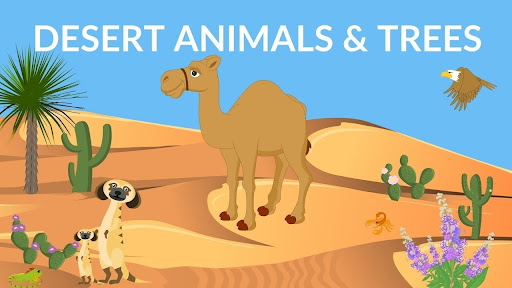
Deserts mein bahut hot climate hota hai. Yaha par day time mein bahut heat hoti hai aur night mein thoda cool ho jata hai. Sabhi organisms iss climate mein rehne ke liye different types se adjust karte hai. Eg- Camels ke paas long legs hoti hai jiski help se woh day time mein khud ko intense heat se bachate hai; kuchh organisms jaise snakes, rats, etc. ki long legs nahi hoti toh yeh day time mein sand ke andar deep burrows mein rehte hai aur sirf raat ke time bahar aate hai.
Agar hum plants ko dekhe toh desert mein jo bhi plants hote hai unme bahut small leaves hoti hai, spines ki form mein hoti ha ya absent hoti hai. Yeh desert plants ki ek adaptation hai kyonki desert mein water ki kami hoti hai aur spines, small leaves mein se transpiration kum hota hai toh water loss bhi less hota hai toh plants ka survive karna easy ho jata hai. Aise plants mein photosynthesis stems ke through hota hai. Desert plants ki stem thick waxy layer se bhi covered hoti hai taki yeh tissues mein water ko retain kar sake.
Mountain Regions

Mountain regions bahut cold aur windy hote hai aur kuchh areas mein toh winters mein snowfall bhi hota hai. Yaha par bhi plants aur animals ki bahut vast variety present hai. Yaha par bhi plants aur animals mein climate ke according adaptation dekhi jati hai. Hum jitni jyada height par jayenge hamein utni hi different adaptations dekhne ko milengi. Eg- Mountains mein normally trees cone shaped hote hai aur inki sloping branches hoti hai. Inki leaves bhi needle ki tarah hoti hai taki rain water aur snow easily slide kar sake.
Mountain regions mein rehne wale animals ki bhi waha ke according adaptations hai. Unki skin aur fur bahut thick hota hai taki cold se unko protect kar sake. Eg- Yaks ke long hairs unko warm rakhte hai aur cold se protect karte hai, snow leopard ke body (including feet and toes) par thick fur ki layer hoti hai taki yeh snow par achhe se walk kar sake.
Mountain goats ke strong hooves hote hai taki yeh rocky slopes par easily run kar sake.
Grasslands

Ab hum grasslands mein rehne wale kuchh organisms ke features aur unke uses ke baare mein janege.
Eg- Lion ek strong animal hai jiska colour light brown hota hai yeh apne se weak animals ko hunt karke khata hai. Lion ek predator (hunter) hota hai, iska light brown colour isko apne prey ko hunt karne ke liye dry grasslands mein hide hone mein help karta hai, iski eyes face ke front par hoti hai jo isko iske prey ki correct location ka idea deti hai.
Deer bhi forests aur grasslands mein rehta hai. Iski eyes head ke side par hoti hai taki yeh sabhi directions mein apne predators ko dekh sake, predators ki movements ko sunne ke liye inke ears bhi long hote hai aur inki speed inko predators se door bhagne mein help karti hai.
Iss tarah se different adaptations ke sath different plants aur animals different conditions mein survive karte hai.
Some Aquatic Habitats
Oceans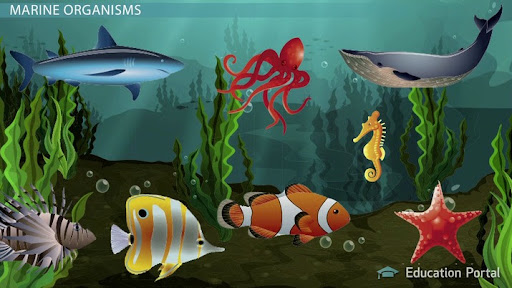
Oceans mein mostly animals ki body streamlined hoti hai taki woh easily water mein move kar sake. Lekin kuchh animals aise bhi hote hai jinki body ki streamlined shape nahi hoti eg- squids and octopus etc. yeh ocean mein bahut niche seabed ke paas rehte hai aur jo bhi prey inki taraf aata hai unko catch kar lete hai. Jab bhi inko water mein move karna hota hai yeh apni body ki streamline shape bana lete hai. Aise animals mein gills present hote hai woh organisms ko water mein dissolved oxygen lene mein help karte hai aur jinme gills present nahi hote (eg- whales and dolphins) woh nostrils aur blowholes ki help se water mein dissolved oxygen ko inhale karte hai. Aise organisms jo nostrils aur blowholes se breathe karte hai woh water surface ke paas aa-kar breathe karte hai otherwise woh water ke andar bina breathe kiye rehte hai aur time-to-time surface par aa-kar breathe karte hai.
Ponds And Lakes
Ponds aur lakes mein bhi different varieties of plants payi jati hai, inke plants ki roots water ke niche soil mein fix hoti hai. Lekin inki roots ka size reduced hota hai aur inka main function plant ko apne place par hold karke rakhna hai. Inki stems long, hollow aur light hoti hai aur water ke surface tak grow karti hai aur leaves aur flowers water par float karte hai. Kuchh aquatic plants water mein fully submerged bhi hote hai, inme se kuchh plants ki narrow aur thin ribbon like leaves hoti hai jo flowing water mein bend ho jati hai. Aur kuchh plants mein leaves highly divided hoti hai taki water inko damage kiye bina aaram se flow kar sake.

Ab ponds aur lakes mein rehne wale kuchh animals ke baare mein padhte hai. Frogs, usually ponds mein rehte hai aur yeh water ke andar aur bahar dono jagah reh sakte hai. Inki back legs strong hoti hai jo unko leap aur apna prey catch karne mein help karti hai. Inke webbed feets hote hai jo swim karne mein help karte hai.
Ab hum organisms ki characteristics ke baare mein padhenge.
POINT 1
Organisms: An organism refers to a living thing that has an organized structure, can react to stimuli, reproduce, grow, adapt, and maintain homeostasis.
Habitat: The place or environment where a plant or animal naturally or normally lives and grows.
Terrestrial Habitat: Terrestrial habitats are ones that are found on land, like forests, grasslands, deserts, shorelines, and wetlands.
Aquatic Habitat: Aquatic habitat means an area where water is present and provides direct support for a given species, population or community.
Biotic Components: A biotic factor is any living thing that has an effect on an ecosystem.
Abiotic Components: Abiotic components include physical conditions and non-living resources that affect living organisms in terms of growth, maintenance, and reproduction.
Prey: A creature that is hunted and killed for food by another animal.
Predators: A predator is an animal that kills and eats other animals.
Adaptation: Adaptation refers to the changes in the physical and behavioural characteristics of an organism that help them to survive in the changing environment.
Acclimatisation: Acclimatisation is the process in which an individual organism adjusts to a change in its environment allowing it to maintain fitness.
CHARACTERISTICS OF ORGANISMS
Agar hum living organisms ki baat kare to hum sabko pata hai ki kya living hota hai aur kya non-living hota hai. Jaise ki hum human beings living organisms hote hai aur chair ya table non-living hote hai. Koi chiz living hai ya non living yeh hame kaise pata chalta hai. Yeh hamein is tarike se pata chalta hai ki living things grow karti hai aur non living things grow nahi karti hai. Hum study karenge ki koi bhi living organism ke kya kya characteristics hote hai. All living organisms carry out various basic functions like growth, development, nutrition, respiration, reproduction and excretion in order to remain alive.
There are certain characteristics that differentiate living from nonliving-
Living beings are made of cells.
Living beings obtain and use energy.
Living beings grow and develop.
Living beings reproduce.
Living beings adapt to their environment
Living beings respond to their environment or stimuli.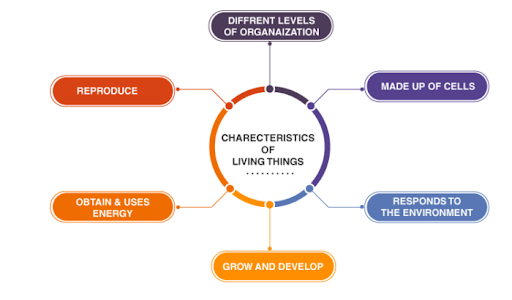
Living Beings need Food
Living beings ko grow karne ke liye food ki jarurat hoti hai. Food ke bina hamara body grow nahi kar sakta hai. Food various functions perform karne ke liye energy provide karta hai.Food nutritious substance hai jo hum daily activities karne ke liye aur energy paane ke liye khate hai. Living beings ko survive karne ke liye food jaruri hai. Hamare liye food jitna important hai utna hi well balanced diet bhi important hai. Food plants aur animals se obtain hota hai. Plants primary producers hote hai. Plants sunlight, carbon dioxide aur chlorophyll ke help se apna khana khud prepare karte hai. Iss process ko photosynthesis kehte hai. Saare organisms directly ya indirectly plants se food obtain karte hai. The process by which animals obtain food and utilize it for all the activities is called nutrition.
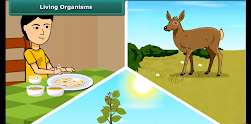
Living Beings Grow
Hamein pata hai ki living organisms grow karte hai. Niche diye figure mein aap dekhenge infant dheere dheere with time grow kar raha hai.
Agar aapse koi puche ki cupboard grow karta hai to aapka answer hoga no aur agar aapse pucha jaye tree grow karta hai to aapka answer hoga yes. Non living things grow nahi karte hai. Living beings ka basic constituent cell hai. Cell is the structural and functional unit of life. Living beings unicellular ya multicellular ho sakte hai. Yeh unke body mein number of cells par depend karta hai. Amoeba aur paramoecium ek cell se bane hai. Isliye inhe unicellular organisms kehte hai. Human being, penguin, mango tree bahut sare cells se bane hai isliye inhe multicellular organisms kehte hai. Cell divide karta hai aur cell ke multiplication ke karan aur cells bante hai, jisse ki aage tissues bante hai, tissues se organs bante hai, organ se organ system bante hai aur phir organism banta hai.
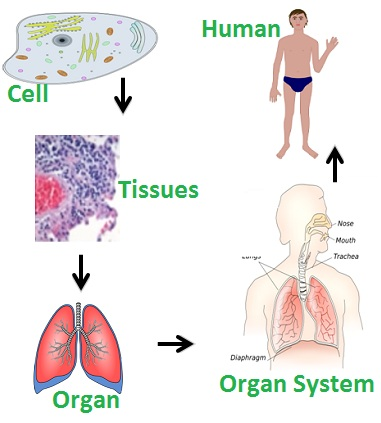
Living Beings Reproduce
Reproduction living thing ka characteristic hai. Agar aapse koi puche ki kya ek chair ek aur chair produce kar sakti hai to aapka answer no hoga par agar aapse pucha jaye kya hen eggs lay karke chicken produce kar sakti hai to aapka answer yes hoga. Plants mein seed ke form mein reproduction hota hai. Plants mein se seeds nikalte hai aur seeds ki help se new plants grow aur develop hote hai. Cow, human being, horse, cat yeh saare apne hi small copy produce kar sakte hai. Fish, frog, insect, lizard yeh eggs lay karte hai aur eggs mein se inhi ka copy bahar aata hai. Reproduction is the biological process by which new organisms are generated from their parents.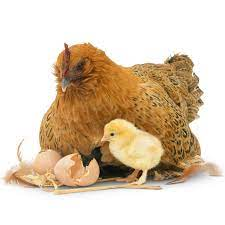
Living Beings Respire
Kya hum breathing ke bina reh sakte hai? Jab hum inhale karte hai to bahar se air hamare body mein aata hai aur jab hum exhale karte hai to air hamari body ke ander se bahar jata hai. Breathing is a part of a process called respiration. Jo oxygen hum breathe in karte hai usme se kuchh oxygen hamara body use karta hai. Iss process mein carbon dioxide produce hota hai jisse hum breathe out karte hai. Cow, buffalo, dog, cat, human being yeh saare similar process se breathe karte hai.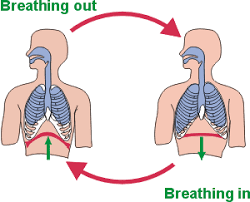
Saare living organisms ke survival ke liye respiration jaruri hai. Respiration ke karan hi hamara body food se energy obtain karta hai. Kuchh animals ke respiration ke different mechanisms hote hai. Example: Earthworm apne skin se breathe karte hai. Fish ke paas gills hote hai pani mein dissolved oxygen ko use karne ke liye.
Kya plants respire karte hai? Haan. Plants me exchange of gases leaves ke through hota hai. Leaves me tiny pores hote hai jisse wo air lete hai. Hamne padha hai ki sunlight me, plants carbon dioxide use krke food produce krte hai aur oxygen release karte hai. Plants mein respiration day aur night hota hai.
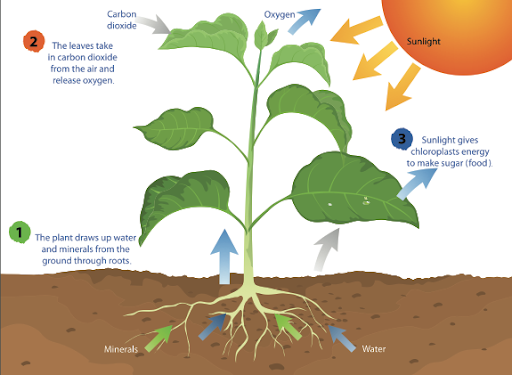
Living Beings respond to Stimuli
Jab aap plant ko window par rakhenge to aap observe karenge ki plant light ke towards bend krta hai. Jab hum ek garam utensil ko touch karte hai to hum apna haath jaldi se piche le aate hai. Is characteristic ko responsiveness to stimuli kehte hai. Living beings respond to the stimulus received from the surroundings. Actions which are in response to something outside the body are called external stimuli. A stimulus is something to produce a response or reaction in a living being. Temperature, light, water, sound, touch and chemical are some external stimuli that living being respond to.
Example: Most common plant is touch me not. i. e. Mimosa pudica. Jaise hi hum iski leaves ko touch karte hai, wo hamesha ek dusre ko fold kar lete hai. Ager hum jor se touch karte to wo murjha jate hai. Aisa hota hai kyunki hamare touch karne se wo respond krti hai. Ye touch stimulus hai aur wo unka response hota hai ki wo droop krte hai.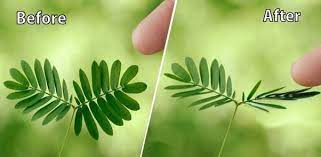
Living beings Excrete
Hum jo bhi khate hai, hamare body mein kuchh na kuchh waste material banta hai aur us waste material ko excrete krna bahut jaruri hota hai taki wo hamare body mein store na ho jaye. Iss process ko excretion kehte hai. Sare living organisms excrete karte hai. The process of breaking down food (digestion) and combining food with oxygen (respiration) produces waste which the organism needs to throw out. The process of throwing out (expelling) waste is called excretion. Faeces aur urine ke form mein hamare body se waste bahar jata hai. Sweating is also a way of expelling waste from the body.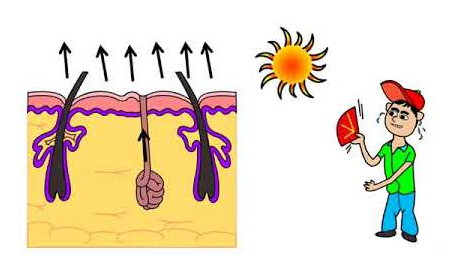
Plants bhi excrete karte hai. Kuchh plants apne parts mein waste products store karte hai us way mein jisse ki wo unhe harm na kare. Kuchh plants secretion ke form mein waste products remove karte hai. Excretion is another characteristic common to all organisms.
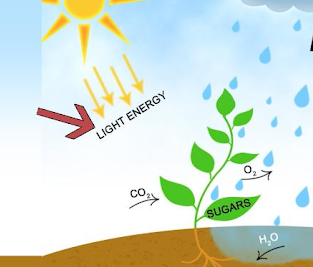
Living beings Move
Living organisms movement show karte hai. Dogs, cats, horses walk and run. Birds and many insects fly. Snakes crawl. Plants generally ek place pr fixed hote hai. Plants bhi kuchh movement krte hai lekin wo apna place change nahi karte. Wo bs grow karte hai, move nahi karte hai. Unke kuchh parts stimuli ke response mein movement show karte hai.
POINT 2
Respiration: A process by which living things produce energy from food. Respiration usually needs oxygen.
Reproduction: Reproduction is the process of producing offsprings that are biologically or genetically similar to the parent organism.
Excretion: Excretion is a process in which metabolic waste is eliminated from an organism.
SUMMARY
1. The surroundings where plants and animals live, is called their habitat.
2. Several kinds of plants and animals may share the same habitat.
3. The presence of specific features and habits, which enable a plant or an animal to live in a particular habitat, is called adaptation.
4. There are many types of habitats, however, these may be broadly grouped as terrestrial (on the land) and aquatic (in water).
5. There is a wide variety of organisms present in different habitats.
6. Plants, animals and microorganisms together constitute biotic components.
7. Rocks, soil, air, water, light and temperature are some of the abiotic components of our surroundings.